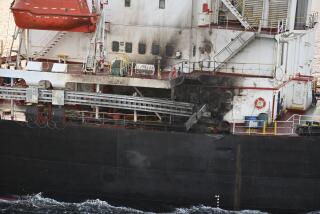NATO sets date to end operation in Libya
- Share via
Reporting from London —
Declaring mission accomplished, NATO Secretary-General Anders Fogh Rasmussen said Friday that the alliance would begin winding down its aerial campaign over Libya with the aim of ending the operation completely by the end of the month.
“We did what we said we would do, and now is the time for the Libyan people to take their destiny fully into their own hands,” Fogh Rasmussen said at NATO headquarters in Brussels.
Ambassadors from the alliance’s 28 member states gave preliminary approval to wrapping up Operation Unified Protector by Oct. 31, seven months after it was launched to carry out a United Nations mandate to protect civilians from forces loyal to Moammar Kadafi.
Until that date, Fogh Rasmussen said, NATO would continue to monitor the situation in Libya and retain the capacity to respond to any residual threats posed by armed supporters of the former Libyan dictator, who died Thursday in circumstances that remain mysterious.
Kadafi’s capture and death came sometime after his convoy was attacked by NATO warplanes outside his hometown of Surt. Fogh Rasmussen repeated NATO’s assertion that it had not set out to assassinate Kadafi and did not know of his presence in the column of armed vehicles, which were bombed because they constituted a potential threat to civilians.
“Such convoys were legitimate military targets,” he said.
The airstrike that paved the way for Kadafi’s capture is now likely to end up as one of the last in a campaign that saw NATO fighter jets fly more than 26,000 sorties since March.
In the name of protecting the Libyan populace, the alliance essentially provided air support for anti-Kadafi forces on the ground, severely weakening his regime and forcing him to flee Tripoli, the capital, amid relentless bombing of government offices, military installations and munitions depots.
Fogh Rasmussen called the revolution in Libya “a special moment in history” not just for the North African nation but for NATO itself.
“Our military forces prevented a massacre and saved countless lives,” he said. “We were fast, flexible, effective and precise.”
The decision to end the operation Oct. 31 is expected to be formally ratified by NATO nations next week.
After that date, no NATO troops or materiel will remain “in the neighborhood of Libya,” Fogh Rasmussen said. “It’s our intention to close the operation. It will be a clear-cut termination.”
Earlier Friday, NATO released more details of the attack on Kadafi’s convoy, which damaged or destroyed nearly a dozen vehicles out of a cluster of about 75 maneuvering around Surt.
A NATO warplane first struck about 8:30 a.m. Thursday after noting the convoy leaving the coastal city “at high speed.” The vehicles were “carrying a substantial amount of weapons and ammunition” that could be used against civilians, NATO said in a prepared statement.
Eleven vehicles were attacked; one was destroyed. About 20 others then broke off from the main column and pushed south, prompting a second airstrike that damaged or destroyed 10 of the vehicles.
“At the time of the strike, NATO did not know that Kadafi was in the convoy,” the alliance’s statement said, adding: “We later learned from open sources and Allied intelligence that Kadafi was in the convoy and that the strike likely contributed to his capture.”
The United Nations’ office for human rights has called for an official investigation into Kadafi’s subsequent death. Fogh Rasmussen said it was up to Libya’s new leaders to decide whether to launch their own special investigation, adding that they ought to adhere to the democratic ideals they have publicly espoused.
“I take it for granted that the new authorities in Libya will live up to their international responsibility, will live up to the basic principles of democracy, including the respect for the rule of law and human rights,” Fogh Rasmussen said.
Times staff writer Paul Richter in Washington contributed to this report.
More to Read
Sign up for Essential California
The most important California stories and recommendations in your inbox every morning.
You may occasionally receive promotional content from the Los Angeles Times.














